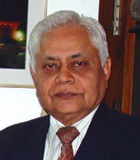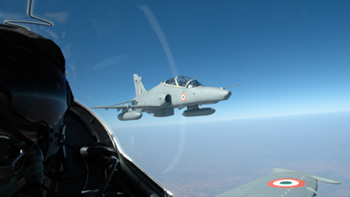INDIAN ARMED FORCES CHIEFS ON OUR RELENTLESS AND FOCUSED PUBLISHING EFFORTS

The insightful articles, inspiring narrations and analytical perspectives presented by the Editorial Team, establish an alluring connect with the reader. My compliments and best wishes to SP Guide Publications.

"Over the past 60 years, the growth of SP Guide Publications has mirrored the rising stature of Indian Navy. Its well-researched and informative magazines on Defence and Aerospace sector have served to shape an educated opinion of our military personnel, policy makers and the public alike. I wish SP's Publication team continued success, fair winds and following seas in all future endeavour!"

Since, its inception in 1964, SP Guide Publications has consistently demonstrated commitment to high-quality journalism in the aerospace and defence sectors, earning a well-deserved reputation as Asia's largest media house in this domain. I wish SP Guide Publications continued success in its pursuit of excellence.
- Prime Minister Modi Visits Punjab’s Adampur Air Base, Interacts with Airmen after Successful ‘Operation Sindoor’; Stern Message to Pakistan
- The layered Air Defence systems that worked superbly, the key element of Operation Sindoor
- Operation Sindoor | Day 2 DGMOs Briefing
- Operation Sindoor: Resolute yet Restrained
- India's Operation Sindoor Sends a Clear Message to Terror and the World – ‘ZERO TOLERANCE’
- Japan and India set forth a defence cooperation consultancy framework, talks on tank and jet engines
Quality issues with HAL products
The crash of a Hawk AJT of the IAF in June this year due to engine failure, has once again shifted focus to quality issue at HAL.
 |
By Air Marshal B.K. Pandey (Retd) Former Air Officer Commanding-in-Chief of Training Command, IAF |

The Indian aerospace major Hindustan Aeronautics Limited (HAL) has once again been in the news; but this time for all the wrong reasons. In the first week of June this year, a twin-seat, single engine Hawk 132 Advanced Jet Trainer (AJT) of the Indian Air Force (IAF) crashed a few minutes after takeoff for a training sortie from the Air Force base at Kalaikunda in West Bengal, apparently on account of engine failure. Being a single engine aircraft, loss of power left the pilots with no option but to abandon the aircraft. This ill-fated aircraft was one of those manufactured by HAL under license with transfer of technology from BAE Systems of the UK. HAL has been tasked to build a total of 99 Hawk 132 aircraft for the IAF. The failed engine that powered the aircraft was an Adour Mk 951 Turbofan from Roll-Royce built under license by HAL. It is understood that quill-shaft failure in the engine is what led to loss of power and is believed to be the primary cause of the loss of the aircraft.
A contributory factor to the poor quality of output by HAL is the rush to meet with production targets towards the end of the financial year.
The accident has been of serious concern for the IAF as the Hawk is reputed to be one of the safest machines to fly and so far, has had an impeccable record of safety. In this case it appears that the failure was premature as the Roll-Royce engine had logged just about 1050 hours of operation. The accident has therefore once again shifted the focus to quality issue at HAL.
Aircraft Losses in the IAF
Over the years, the IAF has been plagued by major aircraft accidents with disconcerting regularity. Over the last 45 years, the IAF has lost as many as 1100 combat aircraft for reasons attributable largely to technical failure and some for other reasons such as human error and bird hit. This works out to an average of 24 aircraft lost per year. This year alone, apart from the loss of the Hawk AJT, the IAF had lost six combat aircraft. The list includes two MiG-27, two Jaguars and one each of MiG-21 and Su-30 MKI. Of all the fleets, the IAF has experienced serious quality issues with aircraft of Russian origin of older generation manufactured under license and/or maintained by HAL. These include the MiG-21, MiG-27 and the MiG-29 fleets. In fact, owing to the frequent crashes, the MiG-21 aircraft had acquired the notorious reputation of being a “flying coffin”. Crashes occurred frequently on the MiG fleet primarily as it was afflicted by engine failure owing to technical glitches such as oil leak, metallic particle in oil filters and hot air leak from rear casing to trouble in compressor and even in turbine of MiG-27 aero engines. In the last 11 incidents on the MiG 27, the aircraft suffered Low Pressure Turbine Rotor failure.
Quality is the Bane
One of the contributory factors to the poor quality of output by HAL especially on aircraft engines is the rush to meet with production targets towards the end of the financial year. In one particular year, HAL overhauled four engines of the MiG-29 aircraft in the first six months of the financial year. However, in the last three months of the same financial year, under pressure to meet with deadlines, the Indian aerospace major completed overhaul of four engines. Compression of time by 50 per cent would have undoubtedly had deleterious effect on the quality of work output. What is more shocking is that while HAL took nine months of the financial year to overhaul nine engines, interestingly it was able to complete overhaul of another nine engines in the last three months of the same financial year!
Even with the fourth generation Su-30 MKI programme, HAL has been found to be wanting in respect of quality of manufacture and maintenance. Apart from the inordinate delay in the delivery schedule of the Su 30 MKI ordered with HAL, the fleet has been plagued by serious technical problems. The IAF has lost a number of Su 30 MKI aircraft on account of technical failure. Most recently, the two pilots flying a Su 30 MKI while approaching the runway to land suddenly found themselves catapulted out of the cockpit with neither of them having operated the ejection system. The quality of product support provided by HAL is more than evident by the fact that the overall fleet serviceability of the Su 30 MKI hovers around 55 per cent as opposed to the minimum stipulated of 70 per cent to meet with operational tasks.
Over the years, the IAF has lost 50 per cent of its MiG fleet and nearly 200 fighter pilots. A majority of the accidents have been caused by flaws in the manufacturing or deficiencies in the overhauling process. HAL of course has been reluctant to face quality issues squarely and has usually been in the denial mode. It is not without reason the Dassault Aviation of France was unwilling to stand guarantee for the quality of product and delivery schedule if the company was compelled to join hands with HAL to produce the Rafale combat jet in India. This proved to be the nemesis for the tender for 126 medium multi-role combat aircraft after lingering for eight years.
HAL’s inefficiency is helping impart fresh impetus to the private sector in the Indian aerospace industry.
In the case of the Hawk AJT crash on June 03, 2015, as stated earlier, the Rolls-Royce engine manufactured under license by HAL, had logged just about 1,050 hours of operation against an engine operating life of 2000 hours before it is subjected to overhaul. There are reports to indicate that the original equipment manufacturer (OEM) Rolls-Royce did not find the quality control by HAL in the manufacturing of the engine to be satisfactory. Consequently, the OEM has reduced the time between engine overhauls (TBO) of the Adour 951 engine for Hawk AJTs manufactured by HAL from the normal 2000 hours to 1,200 hours.
Dismal Record of Performance
In its initial days, HAL did produce commendable results. It provided the IAF with a highly successful piston engine basic trainer, the HT-2 that served the IAF for nearly four decades. Beginning in the early 1970s, HAL did also provide the IAF with an equally successful jet trainer for the intermediate stage training, the HJT-16 Kiran. The Kiran aircraft has been a pillar of strength for the training of fighter pilots for over four decades and continues to render yeomen service. However, after the HT-2 and the HJT-16, there has been a perceptible decline in the output by HAL in terms of quality of product and maintenance. The HPT-32 that was offered by HAL as replacement of the HT-2, was grounded permanently by the IAF in less than two decades of service on account of its dismal safety record. Despite all effort, HAL was unable to resolve problems of engine failure in flight even when the aircraft was equipped with one of the most reliable engines manufactured by Lycoming that had an impeccable global repute. On account of the inability of HAL to provide a replacement for the HPT-32, the IAF had no option but to procure basic trainer aircraft from abroad. In the regime of jet trainer aircraft, even 16 years after the launch of the programme to develop an Intermediate Jet Trainer (IJT) christened as Sitara and huge investment, availability of the Sitara continues to remain uncertain. Once again, the IAF is left with no option but to explore options to procure an IJT from foreign sources as the Kiran fleet is heading for obsolescence. The story of the replacement of the Cheetah and Chetak fleets with a light utility helicopter (LUH) is also quite similar.
Entry of the Private Sector
For years, HAL has been under the scanner not only for poor quality of product but also for delayed projects, non-adherence to delivery schedules, missing deadlines and huge cost overruns. Even after the 32 years that it took for the Light Combat Aircraft (LCA) Tejas Mk I to be granted Initial Operational Clearance, the Comptroller and Auditor General of India has come out with a scathing report on the serious deficiencies in the platform. As to when the LCA Tejas Mk II will see the light of day, cannot be predicted with any degree of certainty. Similar uncertainty continues to haunt the other programmes related to aircraft required urgently by the Indian armed forces namely the HTT-40 basic turboprop trainer, the IJT Sitara, the LUH and the Light Combat Helicopter.
In the recent years, the credibility of HAL has been eroded considerably. However, its inability to deliver is hastening the entry of the private sector into the Indian military aviation market. Airbus has joined hands with Tata Advanced Systems Limited to produce the C-295 to replace the ageing Avro fleet of the IAF and there are reports of similar joint venture between Airbus and Mahindra Aerospace to produce the LUH. HAL’s inefficiency is helping impart fresh impetus to the private sector in the Indian aerospace industry.





